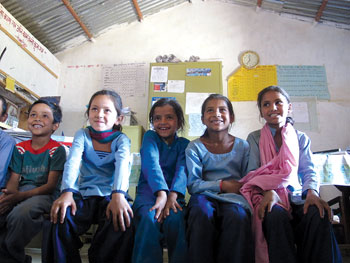Surendra Shrestha served in the United Nations Environment Program’s Rio+20 Secretariat as Team Leader for Institutional Framework for Sustainable Development that is drawing up new sustainable development goals for the 21st century. He explained the goals to Nepali Times during a visit to Kathmandu this week.
Nepali Times: Having been involved in negotiations at the United Nations for new Sustainable Development Goals, can you tell our readers what these goals are meant to be and why they are important?
Surendra Shrestha: The SDGs are meant to be a coherent, collective response of 193 member states of the UN to the multiple crises that humanity faces. The goals are important because they are about our children and collective actions for survival and existence on planet Earth.
The world population has grown exponentially since the start of the industrial revolution. We are now 7.3 billion and, in two decades, the population is expected to stabilise at nine billion. Our resource intensive lifestyle is depleting natural resources and environment services faster than nature is able to replenish them. The intensity and frequency of natural disasters are increasing due to climate change. Inequality is causing civil unrest. Current scientific knowledge compels us to have a more holistic approach to address these crises as countries. The SDGs are a part of discussions at the United Nations General Assembly for the post-2015 Development Agenda that will set the direction for the rest of the 21st century.

KUNDA DIXIT
So, the SDGs have been influenced by the success of the
Millennium Development Goals?
The MDGs have brought the international community together around eight mainly social goals for developing countries. These targetted the ‘bottom billion’ and provided direction and focus for the donor community. MDGs that expire in 2015 have shown that collective action is possible when there is agreement at the global level and have had an impact on the current discussions for SDGs and post-2015 Development Agenda in both the process and content. Through a more inclusive process, 70 UN member states are discussing and negotiating the SDGs and they have also recognised the need for sustainable development with equal treatment of all three dimensions -economic, social, and environmental- in the implementation. The SDGs will be for all countries, not just for developing ones, and will work on priorities that now need to be clustered into a few goals that build on the MDGs.
Aren’t century-long targets too long? How are we ever going to make sure the targets are met?
The discussions at the UN on SDGs are ongoing and is hoped to be completed by September 2015. The goals will be an action plan for the next 15 years with immediate and urgent actions to achieving long-term goals. At the global level, SDGs will be aspirational and universal, and a participatory approach will help countries define national targets to meet these goals. The metrics will be important and common indicators will ensure the measurement will be a part of national statistical bureaus.
Are there going to be resources for poorer countries to meet the basic needs targets?
An expert working group on finance from over 30 countries will begin deliberations on finance for sustainable development. Given the current financial landscape, the discussions will include ODA, technology support as well as issues such as trade. The BRICS countries are expected to play a bigger role in both the governance and contribution of the financial architecture for the 21st century.
Nepal has made dramatic progress in attaining almost all of the MDGs. What are our prospects vis-a-vis SDGs?
Nepal is a member of the Open Working Group on SDGs and will be a signatory to the SDGs when it is completed in 2015. The Planning Commission will need to embrace the SDGs in its planning process and, as a country in the less developed category, Nepal will receive external assistance to achieve the SDGs like the MDGs with political support.
Personally, what was the most challenging part of the negotiations?
In the Secretariat it was to communicate to the negotiators the complex technical issues in a simple easy to understand briefs and to understand the group dynamics to reach a consensus on a given topic and their interconnectedness to other topics.
GOALS FOR THE 21ST CENTURY
Millennium Development Goals 2015
1 End poverty and hunger
2 Achieve universal primary education
3 Promote gender equality and empower women
4 Reduce child mortality
5 Improve maternal health
6 Combat HIV/AIDS, malaria, and other diseases
7 Ensure environmental sustainability
8 Develop a global partnership for development
Proposed SDG Focus Areas
1 Green jobs, youth employment, and social inclusion
2 Energy access, efficiency, sustainability
3 Food security and sustainable agriculture
4 Water
5 Sustainable cities
6 Management of the oceans, fisheries, and other marine resources
7 Improved resilience and disaster preparedness